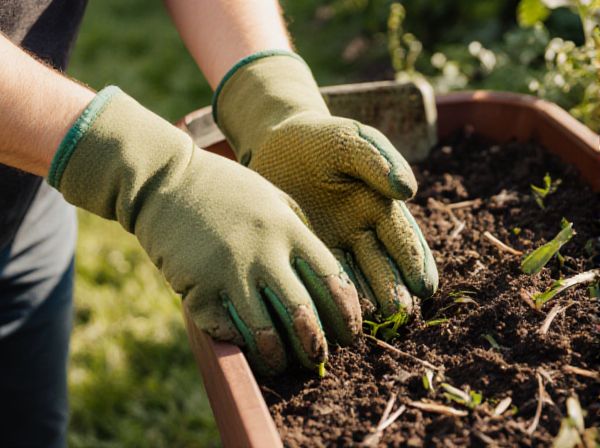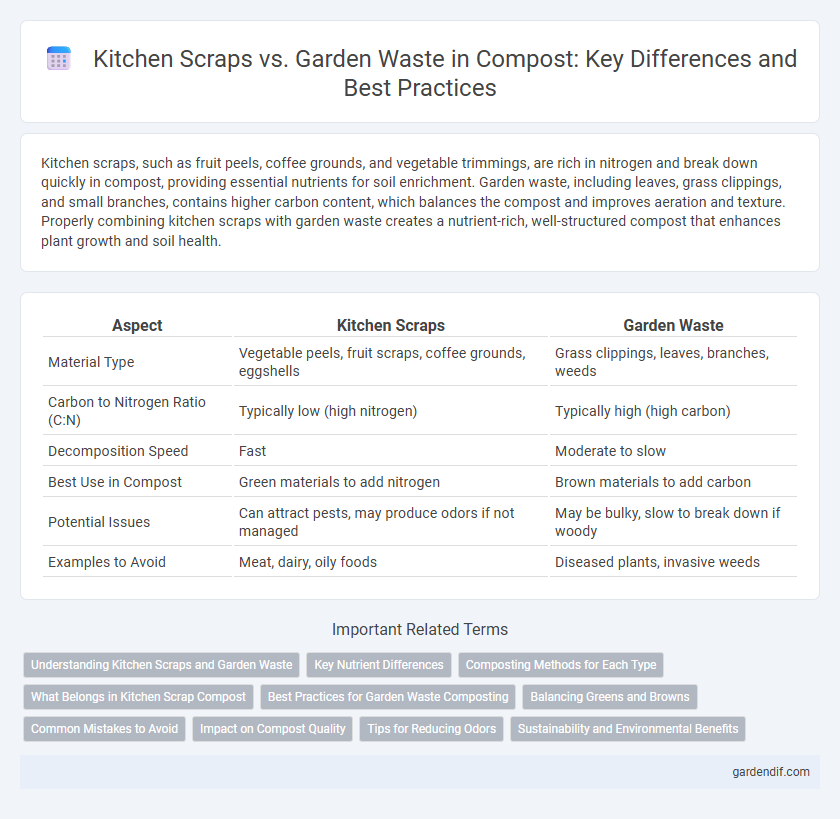
Kitchen Scraps vs Garden Waste Illustration
Kitchen scraps, such as fruit peels, coffee grounds, and vegetable trimmings, are rich in nitrogen and break down quickly in compost, providing essential nutrients for soil enrichment. Garden waste, including leaves, grass clippings, and small branches, contains higher carbon content, which balances the compost and improves aeration and texture. Properly combining kitchen scraps with garden waste creates a nutrient-rich, well-structured compost that enhances plant growth and soil health.
Table of Comparison
| Aspect | Kitchen Scraps | Garden Waste |
|---|---|---|
| Material Type | Vegetable peels, fruit scraps, coffee grounds, eggshells | Grass clippings, leaves, branches, weeds |
| Carbon to Nitrogen Ratio (C:N) | Typically low (high nitrogen) | Typically high (high carbon) |
| Decomposition Speed | Fast | Moderate to slow |
| Best Use in Compost | Green materials to add nitrogen | Brown materials to add carbon |
| Potential Issues | Can attract pests, may produce odors if not managed | May be bulky, slow to break down if woody |
| Examples to Avoid | Meat, dairy, oily foods | Diseased plants, invasive weeds |
Understanding Kitchen Scraps and Garden Waste
Kitchen scraps include fruit and vegetable peels, coffee grounds, eggshells, and small amounts of bread, all rich in nitrogen and ideal for composting. Garden waste consists of leaves, grass clippings, twigs, and plant trimmings, providing carbon and balancing the compost's green and brown materials. Properly combining kitchen scraps and garden waste promotes efficient decomposition and nutrient-rich compost production.
Key Nutrient Differences
Kitchen scraps are rich in nitrogen, essential for promoting microbial activity and accelerating compost decomposition. Garden waste typically contains higher carbon content, providing the necessary energy source for microbes and balancing the carbon-to-nitrogen ratio in compost. Combining these two waste types ensures an optimal nutrient blend that enhances soil fertility and structure.
Composting Methods for Each Type
Kitchen scraps, rich in nitrogen, decompose efficiently using methods like vermicomposting and bokashi fermentation, which preserve moisture and accelerate microbial activity. Garden waste, often high in carbon, benefits from traditional aerobic composting or windrow composting to maintain adequate aeration and balance carbon-to-nitrogen ratios. Tailoring composting methods to each waste type optimizes nutrient cycling and enhances soil enrichment.
What Belongs in Kitchen Scrap Compost
Kitchen scrap compost typically includes fruit and vegetable peels, coffee grounds, eggshells, and tea bags, all rich in nitrogen that accelerates decomposition. Avoid adding meat, dairy, and oily foods as they attract pests and cause odors. Properly sorting kitchen scraps ensures a balanced compost that supports healthy microbial activity and nutrient-rich soil.
Best Practices for Garden Waste Composting
Garden waste composting requires shredding branches and twigs to accelerate decomposition while maintaining a balanced carbon-to-nitrogen ratio. Incorporating green materials such as grass clippings and ensuring proper aeration through regular turning enhances microbial activity and prevents odor buildup. Avoiding kitchen scraps in garden waste piles reduces pest attraction and maintains ideal compost temperature for effective breakdown.
Balancing Greens and Browns
Balancing greens and browns is essential for effective composting, where kitchen scraps provide nitrogen-rich greens, including fruit peels, vegetable scraps, and coffee grounds. Garden waste supplies carbon-rich browns such as dried leaves, grass clippings, and twigs that help aerate the pile and prevent odor. Maintaining a ratio of approximately 2:1 browns to greens ensures optimal microbial activity and faster decomposition.
Common Mistakes to Avoid
Kitchen scraps often contain meat, dairy, and oils that slow composting and attract pests, unlike garden waste which typically breaks down faster and is cleaner. Mixing these improperly or failing to balance green and brown materials causes odor and poor decomposition. Avoid adding diseased plants or chemically treated garden waste to prevent contaminating the compost.
Impact on Compost Quality
Kitchen scraps, rich in nitrogen and moisture, accelerate decomposition and produce nutrient-dense compost, enhancing soil fertility. Garden waste, primarily carbon-rich materials like leaves and stems, helps maintain the ideal carbon-to-nitrogen balance, improving aeration and preventing odors. Combining kitchen scraps with garden waste optimizes microbial activity, resulting in high-quality, well-balanced compost suitable for diverse plant growth.
Tips for Reducing Odors
Balancing kitchen scraps and garden waste in compost helps reduce odors by maintaining a proper carbon-to-nitrogen ratio, ideally around 30:1. Incorporating dry, brown materials such as leaves, straw, or shredded paper absorbs excess moisture and limits the smell from nitrogen-rich food scraps. Regularly turning the compost aerates the pile, promoting aerobic decomposition and preventing the buildup of foul odors caused by anaerobic conditions.
Sustainability and Environmental Benefits
Kitchen scraps, rich in nitrogen, and garden waste, high in carbon, create a balanced compost that enhances soil fertility and reduces landfill waste. Composting these organic materials decreases methane emissions, mitigates climate change, and promotes sustainable gardening practices. Utilizing both types of waste supports resource conservation by recycling nutrients back into the ecosystem, fostering healthier plant growth and reducing reliance on chemical fertilizers.
Kitchen Scraps vs Garden Waste Infographic

 gardendif.com
gardendif.com